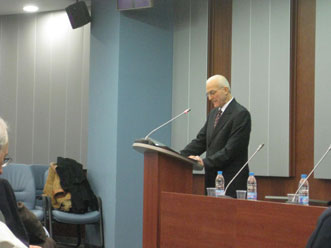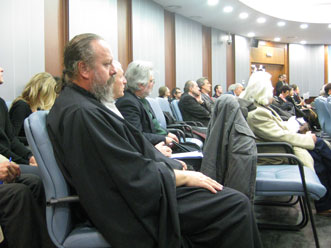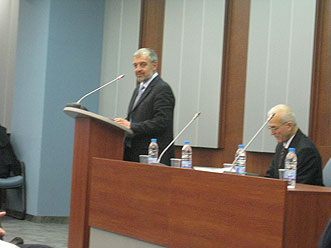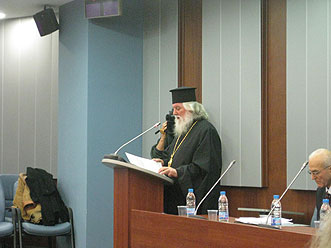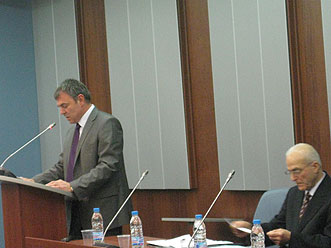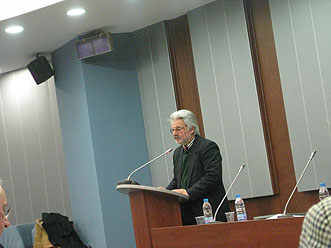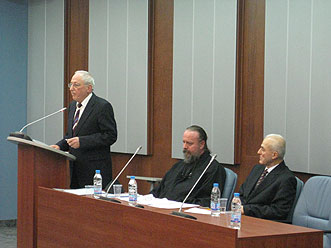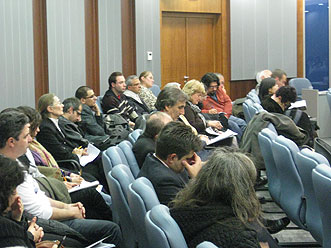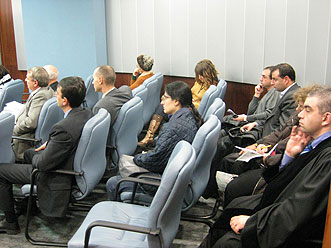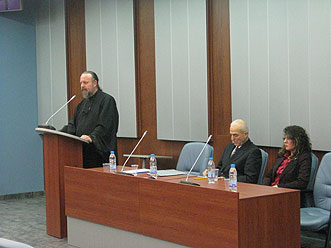International Conference in Sofia ( 13.11.2009 )
The Role and Functions of the Religious Guide Metropolitan of Strumica Naum The position of leadership in the Church originates, externally, from the hierarchical establishment and from the priesthood’s authority, and internally, which is a more important condition, from the spiritual maturity and the preparation of the priestly rank holder. We will try to explain this the simplest we can. However, beware, all we will read in the following lines that will seem to us like a metaphor is not that. It is only theantropic, Christian ontology. There are three stages of spiritual development: purification of the heart from passions, illumination of the mind, and deification of man’s person—both man’s soul and body. The highest is the stage of deification. The stages of spiritual development are determined most easily by the quality of personal prayer: one who has only oral prayer or prayer of the intellect is at the stage of purification, one who has ascetical mind-and-heart prayer is at the stage of illumination, and one who has unceasing or graceful mind-and-heart prayer is at the stage of deification. There are likewise three priestly degrees or ranks, those of a deacon, presbyter, and Episcope. The highest among them is the episcopal rank or degree. According to the holy Tradition of the Church, the three stages of spiritual development correspond to a respective priestly rank: correspondent to the stage of purification is the deacon’s rank, correspondent to the stage of illumination is the priest’s rank, and to the stage of deification the Episcope’s rank. It would be right and ideal if each bearer of any of the priestly ranks also had inner spiritual coverage for them—that is, when one’s priestly rank were adequate to the respective stage of spiritual development. This is how things are set in theory. In praxis, though, in the life of the Church, it quite rarely happens the bearer of a given priestly rank to have also the inner spiritual coverage for the rank he represents. The further the advancement towards the higher priestly ranks in the Church, the greater the deviation from the ideal: for instance, we may find a deacon who so-so walks on the road of purification of the heart from passions, an illumined presbyter is already a true rarity, and a deified Episcope is a real miracle. Things are a little better, at least for the first two priestly ranks (deacon, presbyter), among the monastics. The previous applies in particular to the monastic communities on Mount Athos (Holy Mountain). By his place and position, the Episcope is the supreme leader in the Church. However, due to the deviation from the abovementioned rule and patristic Tradition—that is, due to the lack of inner spiritual coverage in the bearers of this high clerical rank, at present in the Orthodox Church there exists crisis of efficient institutional leadership. This crisis in the leadership, along with other spheres of church life, manifests itself mainly as errors (on any plane) in the activity of the Church’s high clergy on the one hand, and on the other hand as the people’s distrust of the clergy in general as well as of the Church taken as an institution. For example, how can one trust the preaching about freedom, love, equality, unity, and union among people and nations, of Orthodox Churches that do not recognize each other; or how can one trust the preaching about abstinence, forgiveness, prayer, mercy, helping the ones in need etc. of clerics who live not as they preach? The problem is not much in that whether things are seen and known as in that people feel these things spiritually. At the beginning we said that the position of formal leadership in the Church stems from the hierarchical establishment of the clergy and that the highest among the clerical ranks is the episcopal rank or degree. We ought to provide a brief theological explanation, and it follows. Thus, where the faithful gather at one place around their Episcope to actualize the eucharistic (liturgical) assembly, there the Body of Christ is actualized as well in its entire fullness, i.e. there the mystery of the Divine Dispensation is headed and the Kingdom of God is wholly actualized. At that place and in that manner the Mystery of the Church comes to happen. “The gathering of the people of God at one place is necessary for the existence of the Church, yet the centre of this assembly can only be the person of Christ. The Episcope, for his part, who presides over this assembly, is the icon of the eschatological (eternal and single High Priest) Christ. Since Christ is Head of the Body, the Church, and since this Head is in permanent relationship with and direction towards God the Father, therefore the Episcope, too, as the icon of Christ is president at the Holy Eucharist, which is offered up towards God, i.e. towards His throne. Hence, the Episcope accomplishes gracefully, sacramentally this headship over the Church in the way Christ does it; he is the icon of Christ and is in the place and in the image of Christ. Therefore, there is not and cannot exist any authority over the Episcope, because he is the icon of Christ and Head of the Church gathered around him at the Holy Eucharist. Just as there is no authority over the Godman Christ, thus there is no authority over the Episcope either, who is the icon of Christ. The Episcope as Head of his episcopate or diocese is the sole bearer of real autocephaly i.e. leadership, and this in the aspect of his sacramental activity and in the aspect of his pastoral activity and administrative work alike, with no obligation for him even to ask for anyone’s opinion. Accordingly, he is Head of the Church and there is no other head above him that will decide, instruct, and supervise instead of him. This in short is what the concept leadership signifies sacramentally, as well as pastorally and administratively in the Church. The Episcope, as a shepherd, is free to organize the life of his diocese, in conformity with the dogmas, canons, and the constitution of the Orthodox Church, giving account of this only before God. No one interferes, nor can anyone, in his pastoral work: neither a Local Council of Episcopes (Holy Synod) nor an Ecumenical Council. Let us note here that the first in honor Episcope (Archbishop, Patriarch), too, is entitled to the same rights as any other Episcope; these are rights which are at his disposal only in his diocese. In case he wanted to visit a certain other diocese and engage in certain activity in it, he only could do this with the permission and blessing of the Episcope of the given diocese, and vice versa. The Council of Episcopes, as a body, an institution, may and ought to appear, act, and impose itself only in a case when a certain decision or activity by the Episcope of the local Church is contrary to the dogmas, canons, and constitution of the Local Church and it also negatively affects the life of the other local Churches”.1 Despite the thus, theologically and canonically, firmly established position of the Episcope in the Church, we cannot yet speak about his essential leadership. Why do we, when speaking about the position of the Episcope in the Church, use the term formal leadership? Because the authority of a leader that stems merely from the significance of the institution represented is one thing, while the authority of a leader that stems from the inner spiritual coverage of the rank with which he represents that institution is yet another thing. A true leader is the one we want to follow, not the one we have to follow. Hence, we may conclude: the acquisition of the highest position in the Church as such does not also provide the authority of leadership, nor does the lack of a priestly rank and position of authority in the Church as such imply inability of leadership with authority. On the contrary, in the history of the Church, when the two have not coincided, the charismatic leadership has always had greater authority than the institutional leadership. All the saints of the Church, men and women—martyrs, venerables, and fools-for-Christ, who have not had any priestly rank, are evidence to what we claim; and this most often in their earthly life already. And the greatest evangelical evidence is the Lord Himself, the Godman Jesus Christ, Who, regarding the Old Testament priesthood and Church, had no position of authority and no formal priestly rank whatsoever: “Look, the world has gone after Him!” (John 12:19). Why is that so, we can explain the easiest through the mystery of the priesthood of the woman, which at the same time is the mystery of the royal or inner priesthood, too, to which, through Baptism, we all are called. Let us recap briefly: the priest, by his position (office), represents and heads the Church. The priest is the one who, standing in front of the Church and on behalf of the Church offers the gifts of the Church before the throne of God, before God. He is the one through whom the mystery of the catholic mode of existence is performed: let us entrust ourselves, one another, and our whole life to Christ our God, and in Him, to God the Father. And God, for His part, grants us His divine life. In the “historical period of the Icon” (in this world and age), he is the one who appears in Christ's place and image, performing His work until the day of the Apocalypse. Because, the Godman Christ sacrificed Himself once and for all for the life of the world, and yet, through the Holy Spirit, the Lord, He stayed in the Church, which is Christ extended throughout all the ages. A priest, first of all, is the Episcope. This is the sacramental and institutional dimension of the priesthood. In conformity with the Tradition of the Orthodox Church, the woman does not participate in this dimension of the Holy Mystery of Priesthood. However, this dimension will not exist in the Heavenly Kingdom: there is no need of the Icon where Truth is present. “The priest truly heads the Church, and not merely by position, only if he has previously embraced it and takes care of it in his heart. The purified heart alone can hold within it everyone, including one’s enemies. Only in it can be performed the great mystery of catholic life, of interpenetration. Only in such a heart can pour forth the prayer for the whole world, fulfilled in that ineffable: “Abba, Father!” Only at the altar of the purified heart can the mind invisibly perform sacred actions for the life (salvation) of the world. This is the ascetical-hesychastic and inner dimension of the Mystery of Priesthood. Without this dimension the personal-soteriological character of Priesthood as a Holy Mystery is lost. Of this dimension of priesthood, no one can deprive the woman, either in this or in the age to come. It is a condition for entry in the Truth, in the Heavenly Kingdom, and it is God's gift to every human. This ascetical-hesychastic or inner dimension of the Holy Mystery of Priesthood—in fact genuine repentance—is also a condition for the existence of the Holy Eucharist and of the world, too. According to the Tradition of the Church, the repentance of three people is sufficient for the existence of the Eucharist, and by this of the world as well. These three may well be only women”.2 Hence, it is inner priesthood that has the power to attract and lasts forever. Unless the Episcope has that, he has nothing. Even if the least of people has that, he/she has everything. Inner or royal priesthood is the force that attracts both people and angels, them who do good and them who do evil alike; and no one can be indifferent to it: for we have been made a spectacle to the world, both to angels and to men (1 Cor. 4:9). It is force that attracts without violation of our freedom at that. Normally, it is easy to be attracted by someone who constantly guards and protects you in his heart and in his mind, someone who has made the content of your life content of his life. And it is normal that you will attract, as adversaries, them who are bothered by your godly work. Inner priesthood is power; it is not futile moralizing that interests not a single person. Briefly, the shepherds or church leaders should spiritually guide in the process of purification, illumination, and perfection, the people of God who participate in the Holy Mysteries of the Church. The spiritual father, or shepherd, or leader, must first purify his own heart from the sinful passions, acquire the gift of the mind-and-heart prayer i.e. the gift of inner priesthood, and reach at least to illumination of the mind so that he can lead on the road to purification of the heart and illumination of the mind those followers he will attract toward the Godman Christ and His Church. Them, in whom he will manage to turn their faith into experience and knowledge, he will never lose again. Here is how one of the greatest hesychasts and spiritual leaders of the twentieth century, the Athonite Elder Joseph the Spilaioti, describes this: “God [Himself] enlightens a like-minded practiced elder, an experienced guide able to save souls—or, rather, God Himself dwells in him and speaks through him—to providentially meet with him [with the spiritual child]. And as they talk: behold the return [manifestation] of divine grace [in the heart of the spiritual child]. The elder speaks, and his words penetrate like lightning to the depth of his heart, and divine light encompasses his soul, and the demons flee far away from the elder who has become unbearable to them. For at that moment, the holy elder is all divine fire, his words are filled with divine illumination, his advice is keen, with great wisdom and understanding and full of holy thoughts, for it is accompanied by divine grace. And as soon as that advice enters his [spiritual child’s, disciple’s] heart, his nous [mind] is moved to amazement and wonder, for the elder supernaturally teaches him everything necessary to lift the huge burden of the demons’ evil.”3 The heart of the true spiritual father i.e. leader is sufficiently purified from the passions and therefore gracefully opened, and his mind abides with mourning and prayer in the thus opened heart. This is work and feat in which man’s whole being participates, both the soul—with mind and reason—and the body. Here, in the heart as man’s spiritual centre, comes to happen the mystery of transformation. The grace of Holy Baptism, which springs from the purified heart, transforms the mind, the word, and the person of the spiritual leader. His mind becomes illumined, his word with power, and his presence is a witness to Christ that attracts powerfully and gently. The spiritual leader is a man whose presence is with manifestation of power not towards people but towards the fallen angels. He knows the road to spiritual growth and can lead on it everyone who wants to grow spiritually. The word of the spiritual leader reaches the depth of the spiritual follower’s heart and transforms it from within: brings the light of faith, brings love and strength for the struggle, instills hope in the spiritual warfare and life. Spiritually gives birth and builds up, through the mutual personal relationship, the new, in Christ, man. The relationship spiritual leader—spiritual follower is a Holy Mystery of mutual interpenetration and growing in Christ. Thus, if we do not bring into line our personal state and the ecclesiastical state of affairs with the Holy Fathers’ teaching, we can neither expect any better results in our pastoral i.e. leader’s work. Instead of being the axis around which people and nations will unite, the Episcopes of the Orthodox Church will continue occupying themselves mainly with vainglory (with struggle for power and human glory, with politics and with ethnophyletism or fake patriotism); instead of being the source of consolation and healing, the presbyters will continue occupying themselves mainly with avarice (with the struggle for money and possessions); and the rest of the people, left to themselves, will continue occupying themselves—some (the nominal Christians) with satisfaction of their passions, and others (spiritually not properly guided ones) with slander, lying, judging, and condemnation (of the Episcopes, presbyters, and each other)… Such a bad spiritual state of affairs is a testimony that the Local episcopal Churches are led by Episcopes who have not yet been purified from their passions, and their inner susceptibility to passions, particularly to the passion of ethnophyletism and of high self-esteem, reflects itself as an internal inter-ecclesiastical struggle for power and force that disunites. Certainly, to continue revealing this is not recommendable for them, and by this to nurture as well rather than heal their alarming inner conflict and split personality, creating and maintaining disunity or discord among people and among nations, as well as among the Local Churches. We should also know this: The basic problem that the spiritual child, the follower, faces during the period of spiritual awakening and of purification of the heart from passions is not about whether the spiritual father or leader makes certain mistakes, but whether his spiritual children listen to, follow and trust him, once they have checked him and freely chosen him for their spiritual leader. In that case there is no danger of erroneous guidance since, as we have already said, the relationship spiritual leader—spiritual follower is a Holy Mystery of mutual interpenetration and growing in Christ, and such a relationship is under the direct supervision and providence of God. If the Tradition of spiritual life in the Orthodox Church depended merely on the holiness of spiritual leaders—the apocalypse would have been historically past. If the spiritual leader is holy, that is a very good thing; yet, the struggle of the follower is always personal. Here is what the experienced ones say about the relationship spiritual leader—spiritual follower: “Even if the elder’s instruction is wrong, God will turn it into spiritual benefit because of [the disciple’s] obedience. If someone is obedient, even if the order is wrong, just because of obedience all will end up well. It makes no difference who is the elder giving the command. What use was it to Judas that his Elder was Christ Himself? What use was it to Adam that he was in paradise and His Elder was in a way God Himself? None” (Elder Joseph the Spilaioti).4 “Everything depends on our relationship with God. If we have confidence in His Providence, we will have the courage to follow the word of our spiritual father. The logic proper to everyday life and to our reason is not enough. God abandons the person who has too much confidence in his own intelligence”.5 “It does not matter if a word goes against what we would wish, or if the advice we are given seems to contradict “good sense”; if we are ready to follow it, if we trust our spiritual father, God will in the end always arrange things in a positive way. The mystery of obedience is one of the most cardinal realities on the path of salvation”.6 Nonetheless, even if we say with certainty that some of the leaders of the Church are to be blamed for the pale witness to Christ the Lord or for the scandals among the people, we still must not fall from God, and it is not normal that we do that, for instance, because of the incapability of a certain cleric. The leaders of the church organization are changeable, yet the Church remains forever the place for salvation and the gates of Hades will not prevail it. Shortsighted are the self-justifications of the kind: look what this cleric is doing, and I should go to church!? If we think that anything else but ourselves is the obstacle in our relationship with God, then we abandon the personal relationship with Him and the personal road to Him. If we think and act in this way, we do not live as persons. The leadership in the Orthodox Church is to the glory of God, and not to one’s own glory and interest. It is antinomical leadership—you guide, not by having others serve you but by serving them instead, with an example. It is leadership of personal and powerful testimony to Christ, that leaves no one indifferent. It is leadership that does not depend solely on the leader but also on his followers, on their commitment; it has a catholic, church dimension. The relationship leader—follower is not once and for all established and unchangeable, idolatrous relationship, it is rather a relationship that ought to raise new leaders. Its aim is eschatological: the Kingdom of God. Any other true leadership originates from and is based on this i.e. Christ’s leadership. Thus, we need Shepherds that will renew Orthodox spiritual life and will fan the flames of faith, who in practice and by personal example will actualize the Holy Tradition, who will take care of the unity and primacy by honor among the Churches, who will preserve the dignity (ecclesial fullness) of the local episcopal Church, and also the pastoral authority and credibility of the local Church. In a word, we need holy people. The existence of such Episcopes-leaders will by all means enrich the communication and the dialogue of the Church with the other Christian churches and also with the monotheistic religious communities, with the aim of establishing as much as possible God’s message of peace, tolerance and coexistence among people, in the world that is continuously afflicted with various conflicts. No one who is still, because of solving his inner problems, shut in himself, can open himself to the other one and lend him a helping hand. ________________ 1 Cf., Mitropolit Strumički Naum, Soočuvanje so apsurdot, Veljusa. 2007, p. 23 – 25 2 Cf., Mitropolit Strumički Naum, Slovo od Vodoča, Vodoča. 2002, p. 159 – 161 3 The Letters of Elder Joseph the Hesychast, Monastic Wisdom, St. Anthony's Greek Orthodox Monastery, 1998, p. 363 – 364. 4 Jefrem Katunakijski, Starac, Učenik Krsta – podvižnik poslušanja, Obraz svetački, Beograd. 2002, p. 69. 5 Archimandrite Sophrony (Sakharov), Words of Life, Stavropegic Monastery of St. John the Baptist, Essex. 1998, p. 44. 6 Cf., p. 44. 